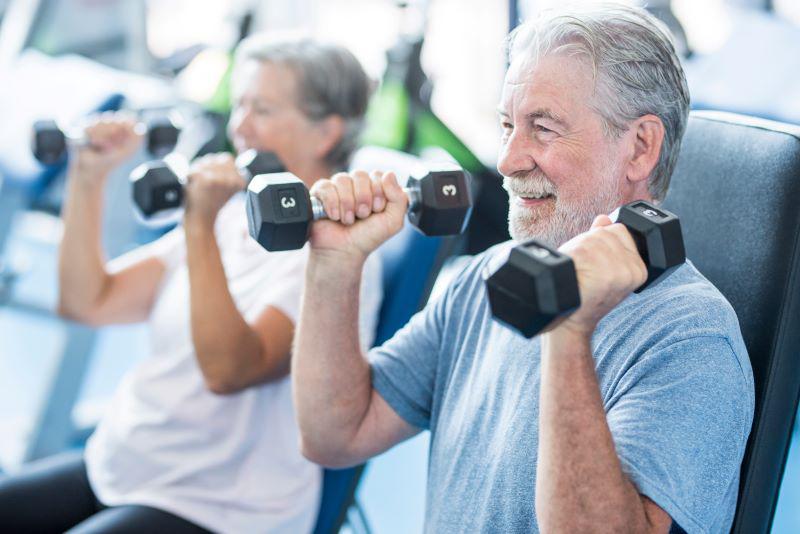Get Healthy!

- Cara Murez
- Posted January 12, 2023
Weightlifting Your Way to Weight Loss
Look at a bodybuilder who has bulked up with bulging muscles, and it might not seem that lifting weights can shed pounds. But first impressions can be deceiving.
Instead, experts say, building muscle can indeed be one way to transform your body and lose weight.
"Weightlifting activates your large muscle groups and, when done appropriately, can burn more calories than steady state cardio,"said Dr. Russell Camhi, who works in primary care sports medicine for Northwell Health's Orthopaedic Institute in Smithtown, N.Y.
Still, weightlifting on its own is not the key to weight loss. At least 80% of weight loss is through nutrition, Camhi said.
"No matter what exercise program you choose you will not lose weight if you are not monitoring your intake and properly fueling your body,"Camhi said.
A person lifting weights to gain muscle mass should eat a high-protein diet, Camhi said. The goal should be 1 gram of protein per pound of body weight.
People who are already fit and trying to gain muscle may not lose weight, but someone who is overweight or obese will, Camhi said.
"Once you lose a good portion of fat and become more fit then, yes, the weight loss will plateau but will be replaced with muscle growth and increased fitness,"Camhi said. "At that point, be less concerned about the number on the scale and enjoy all the benefits that come from increased muscle mass and strength, improved energy, better sleep, less fatigue."
A recent review of studies published in the journal Sports Medicine found resistance training lowers the percentage of body fat, body fat mass and visceral fat in healthy adults.
But regular physical activity and healthy eating are both important for weight loss, according to the U.S. Centers for Disease Control and Prevention.
Muscle burns fat faster
The Cleveland Clinic suggests building muscle is key to burning more calories because muscle burns more than twice as many calories as fat does. The body builds muscle by overloading and then repairing those tiny tears, explains athletic trainer Tom Iannetta.
Among the many benefits are that weightlifting speeds up metabolism, according to the Mayo Clinic.
It also helps improve testosterone levels in men, Camhi said, and is critical for maintaining bone density in women.
"Those who strength train later in life have improved strength as well as balance, which leads to decreased fall risk,"Camhi said.
Weightlifting was also associated with significantly lowering a person's odds of dying early, especially when combined with aerobic exercise, according to a recent study in the British Journal of Sports Medicine.
The risk of early death in those study participants was up to 47% lower in people who met exercise recommendations, including weightlifting, compared with those who didn't exercise, according to researchers at the U.S. National Cancer Institute.
The U.S. Department of Health and Human Services advises Americans to get at least 150 minutes of aerobic exercise per week, plus two sessions of strength training.
Getting started on lifting weights to lose weight
As always, consulting with a professional is a good first step.
A weightlifting routine should start with a warmup, according to the Cleveland Clinic. Meanwhile, the Mayo Clinic also suggests brisk walking or another aerobic activity.
You can do about 12 to 15 repetitions for each exercise with the proper weight to tire the muscles, the Mayo Clinic said. Don't do exercises that cause you pain.
Muscle groups should be rested for an equal time as they are worked, according to the Cleveland Clinic.
Doing each exercise just eight times may be enough, the American Cancer Society (ACS) advises. If you get to 12 repetitions and you're so tired you can barely finish, stop.
Choices for strength-training workouts can include using free weights at home; weight machines or cable suspension training at fitness centers; and lightweight resistance tubing, the Mayo Clinic suggests. Use your own body weight for classic exercises like pushups, lunges and squats.
Use resistance bands for exercises such as arm curls, kicks and squats, the ACS says.
"It is important to start low and go slow,"Camhi said. "Many people move too quickly into weight training and that can lead to injury."
Camhi suggests focusing on simple movements. His list includes goblet squats, lunges, glute bridges, push-ups, dumbbell rows and planks.
"Please keep in mind that fitness is not a 30-, 60- or 90-day challenge. It is a lifelong journey,"Camhi said. "Those who succeed understand that changing your physique is not a quick change. It takes time and consistency."
SOURCE: Russell Camhi, MD, primary care sports medicine, Northwell Health Orthopaedic Institute, Smithtown, N.Y.







